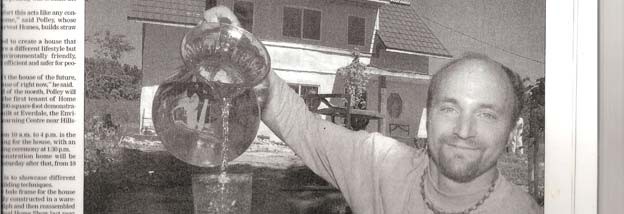Area builder takes shot with unusual material – The Ottawa Sunday Sun
Staff Writer
Please Forget all of the jokes about the three little pigs and the big, bad wolf. Chances are Ben Polley has heard yours, as well as dozens of others before.
That’s a hazard of the business when you make y our living, as Polley does, building straw houses. Not that his are likely to come crashing down with a gust of air. In fact, Polley said in an interview, they will continue to stand when “traditional” houses have been blown over by hurricane-force winds.
Polley demonstrates the patience of Job in explaining the concept of straw housing to a reporter who can’t seem to shake the image of a thatched hut standing in the middle of a field.
For starters, these houses don’t look much different than those built with more traditional materials.
Beginning with a conventional foundation, he stacks the bales of straw to the desired height of the house, and caps it off with a wooden top plate that secures the bales to the base.
“Think giant Lego and you’ll get an idea.” says Polley.
Virtually Fireproof
After that, the entire structure is covered inside and out with an inch-thick layer of plaster, and topped off with a conventional roof.
The result is a virtually fire-proof, well-insulated home that needs no air conditioning and costs far less than a wood-frame building, he said.
A 1,500 sq.-ft bungalow will use about 500 bales of straw, available for between $1 and $300 each – “a fraction of the cost of framing,” he said.
It won’t burn, said Polley, because the bales are packed together so tightly there is no air to support combustion.
The straw provides an insulation value of somewhere between R-35 and R-50, at least twice as high as the standard, he said.
Inside the home, the air quality is unbeatable, he said, because the straw acts as a natural filter. “In fact, indoor air quality is better than a conventional home with an air exchange system.”
Stigma Remains
So if they’re attractive, economical, environmentally friendly and built to last, why aren’t straw homes popping up all over?
“There’s still a bit of a stigma attached to them,” admits Polley.
“We need more of an educational process.”
In other jurisdictions they have been around for decades, he said, with 100 year old straw houses still standing in areas like New Mexico and Nebraska, where trees are scarce and lumber expensive.
Even Regina has a straw-bale subdivision.
Locally, there are a few, but the owners don’t really like to identify themselves because of the attention they would attract.
Polley’s company, Harvest Homes, provides both contractor and consultant services. In other words, he and his crew will come and put up the building, or provide advice and training to do-it-yourselfers.

